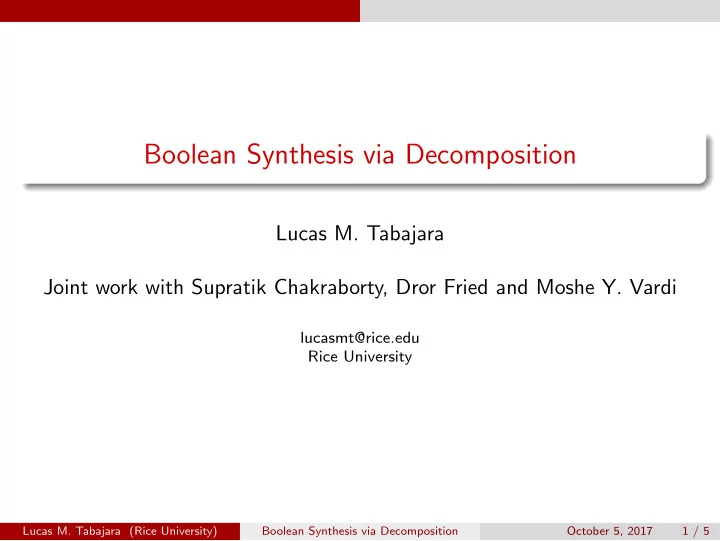

Boolean Synthesis via Decomposition Lucas M. Tabajara Joint work with Supratik Chakraborty, Dror Fried and Moshe Y. Vardi lucasmt@rice.edu Rice University Lucas M. Tabajara (Rice University) Boolean Synthesis via Decomposition October 5, 2017 1 / 5
Boolean Synthesis g f ( x 0 ⊕ y 0 = 0) y 0 := x 0 ∧ y 1 := x 1 ⊕ x 0 ( x 1 ⊕ y 1 ⊕ ( x 0 ∧ y 0 ) = 0) Boolean function Specification of a system implementing system behavior encoded as a Boolean formula Our goal: To decompose the specification into formulas that are easier to synthesize. Lucas M. Tabajara (Rice University) Boolean Synthesis via Decomposition October 5, 2017 2 / 5
Decomposition using Factored Formulas F ( � x , y 1 , y 2 , y 3 , y 4 ) = F 1 ( � x , y 2 , y 4 ) ∧ F 2 ( � x , y 1 , y 2 , y 3 ) ∧ F 3 ( � x , y 3 ) ◮ Easy to perform decomposition. ◮ Has been shown to significantly improve synthesis algorithms. However: Dependences between factors prevent us from taking full advantage of the decomposition. Lucas M. Tabajara (Rice University) Boolean Synthesis via Decomposition October 5, 2017 3 / 5
Towards Sequential Decomposition Sequential Decomposition Given: A Boolean formula F ( � x , � y ) between input variables � x and output variables � y . Return: Two Boolean formulas F 1 ( � z ) and F 2 ( � y ) that can be x , � z , � composed back into F . Lucas M. Tabajara (Rice University) Boolean Synthesis via Decomposition October 5, 2017 4 / 5
Sequential Decomposition F F 1 F 2 g 1 g 2 Lucas M. Tabajara (Rice University) Boolean Synthesis via Decomposition October 5, 2017 5 / 5
Sequential Decomposition g � z g 1 g 2 � y � x Lucas M. Tabajara (Rice University) Boolean Synthesis via Decomposition October 5, 2017 5 / 5
Recommend
More recommend